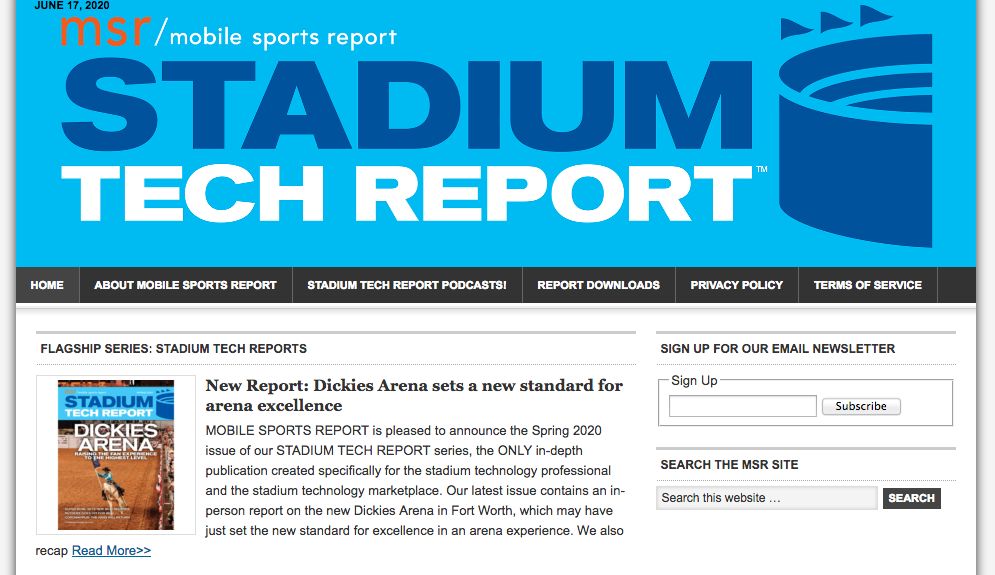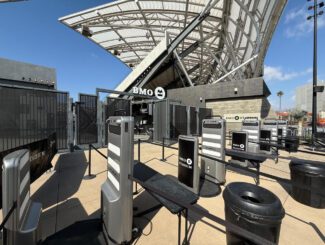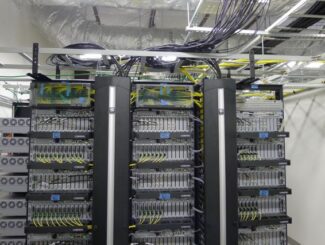
Welcome to the strangest time ever for sports. For venue technology professionals, it’s even tougher, since they need to not just deal with the present but also must plan for the future. And that would be an incredibly uncertain future, with uncertain needs, perhaps fulfilled by untested technologies, which need to be paid for at a time when no money is coming in. All that makes it tough to show up for work every morning.
As much as we can from our home offices, we feel your pain. And in what we hope is a good move for us and our readers, we are taking a big step toward providing even more information we hope will help you with your jobs. As of today, the entity formerly known as Mobile Sports Report will now be known as Stadium Tech Report. What does that mean for you? Quite simply, it just means “more.” Let me explain, with a quick look back at where we came from:
When I started Mobile Sports Report nine years ago, we had a fairly uncertain focus. The only thing we
really knew was that digital technology would impact the consumption of sports in huge ways. It wasn’t that bold of a prediction, but what was unclear was what would matter most, and what we could make a business out of covering. In our business, that means finding an audience that needs information about a topic that matters to them. Would it be watching football on your phone? Would it be sports social media? Would it be figuring out wireless connectivity in stadiums? We covered a lot of topics at the start, and the title “Mobile Sports Report” was chosen purposely to be non-specific, giving us latitude to move wherever it made sense to move.
In 2014, we launched what would become the focal point of our business: Our quarterly “Stadium Tech Report” series, which began with a venue-by-venue survey of the wireless connectivity at each NBA arena, and a few profiles of deployments at stadiums, including the brand-new Barclays Center. The simple idea then remains powerful today: Since deploying wireless in stadiums is a complex and unique problem for each venue, we needed time and space to tell the stories completely, so that other technology professionals could learn and inform their own plans and strategies.
With team, school and venue reps telling us for years that wireless connectivity (or lack thereof) was one of the biggest pain points for fans, it made sense to focus on that part of the stadium technology puzzle. Over the years, we’ve had a front-row seat to all the trials and errors of Wi-Fi and cellular deployment strategies and told as many tales as we could, covering both the highs and the lows.
Along the way our audience steadily grew from friends and family at the start to a mailing list now
surpassing 4,000 active members, attracted we think in no small part by our commitment to honest, objective journalism. There is no pay to play at our house, no stories done in exchange for sponsor dollars. Our business premise has always been, that if you deliver a solid, honest product, the audience will appreciate it, and sponsors will want to reach those readers by showing their support for the outlet of the information. The continued interest of our readers and the continued support of our sponsors is an
honor we cherish.
Stadium Tech Report was called that for a reason
But just like we called the main publication “Mobile Sports Report” for flexibility, there also was a reason why we purposely called our flagship publication “Stadium Tech Report,” and not something with mobility or wireless in the title. Yes, mobility and devices will always be at the forefront of any game-day experience and even more so going forward, especially as digital interactions will likely replace
many human ones for safety reasons in the near future. But now more than ever, more technology will come into venues, in areas only remotely related to mobility. Scanners, digital signage and camera systems will become need-to-know-about technology now added to the to-do list for IT teams inside venues. And we will embrace those with the same direction as we did with wireless.
It’s a subtle but necessary change. It may not seem so to those on the outside reading in, but titles matter. You are, at some point, what you say you are on the biggest sign you have – a Restaurant, a Dry Cleaner (that is equipped with one of the best of Dryers in town), a Pet Store. Changing our main name to Stadium Tech Report says, out loud, that all technology for stadiums and other large public venues is now in our purview. That doesn’t mean we’re going to back down at all from our perch where (in our humble estimation) we cover stadium wireless technology more closely, deeply and objectively than anyone else out there. What the name change says is: We’re going to take the same approach with every other technology that goes inside the arenas, mainly because that’s what’s happening to our audience.
If they need to become instant experts on thermal imaging and detection, self-serve concessions operations, or AI-assisted crowd camera systems, we want to help them on that learning curve.
Watch for more improvements as the summer rolls on – we have some new directions coming in design and content to better address the changing way our audience consumes what we put on the table. It may also take a little bit of time to shake the MSR genes out of our system (you will ALWAYS be able to reach me at kaps at mobilesportsreport.com, and for now the site’s URL is still mobilesportsreport.com, for instance) but I am sure you can deal with the pace. We are working on a new site design as well, but as usual, editorial content takes precedence so we’ll start with the official name change and go from there.
Talking to all the smart people we can
One of the first endeavors is a joint research/editorial project with our friends at AmpThink we are calling the “Return to Venues,” an open-ended idea to expose all the best ideas, thinking and practices of the smartest people we know in the business in regards to the challenges presented by the coronavirus. We’re still in the process of putting this all together, but stay tuned for more in-depth reports, more live or recorded interviews, and other things all meant to help elevate the shared discussion about where we’re all headed next. Our initial report on What’s Next for venues in our new Stadium Tech Report issue was the end product of more than two months of joint interviews with AmpThink folks, talking to everyone we could at technology companies, stadium tech integrators, team and school IT leaders, and other smart people. We’ve learned some amazing things and got great direction on where to head next so stay tuned.
In the narrow-focus field of stadium technology, it’s going to be an incredible time over the next six months, over the next year, over the next two years. There’s going to be lots of experiments, some of which may bear fruit, some which may flame out, and others that will need tweaking and lots of trial and error before things work the way they should. We’ve seen this story before, if you think about ideas like in-seat delivery and stadium apps. What sounds great in a first headline doesn’t always translate to success in the seats. You can expect a lot of this in the days to come, where every “new” thing is touted as a savior, especially by those without a lot of background in the business. But will they follow up to see if those things worked, and if not, how venues eventually solved the problems? We will. Like you, we’re in this for the long haul.
For the nuts and bolts that matter – how will you install and run it, how will it be paid for, what is the total cost of ownership, will it really be necessary two years from now – you can count on us and our great audience, our readers who are our sources, to help figure out what works and what doesn’t.
If you think about it in math terms, running tech at an arena just went from algebra straight to calculus, no stops in between. Instead of just trying to figure out if you want your Wi-Fi antennas overhead or under-seat, now you have to contemplate an entirely new way of getting fans into a stadium, perhaps scanning them for body temperature or blood-oxygen levels on the way; you may have to completely reroute concourses and pathways to seats, sometimes in stadiums that were originally built over 100 years ago; And you may have to remake everything you ever did on a concessions standpoint, as the entire world switches to contact-free payment systems and shies away from someone taking your order face to face, taking your money and then wrapping and handing you a hot dog.
And just for kicks, the need for all the critical wireless networks underlying everything doesn’t go away, it only gets more necessary as all the new stuff like cameras, sensors, displays and POS terminals will need more, not less, connectivity. Same with outreach to fans and staff, who will all need more, not less, communication. It’s scary stuff, almost as scary as the pandemic that has caused the shutdown.
But staying still or moving backwards is not an option. That’s the same for us, and it’s why we chose this time to double down on what we do, mainly again because what we’ve learned in a two months of deep-dive interviews. Nobody knows what’s happening, there is no silver bullet, no single plan of action. It’s going to take a lot more Zoom calls, trials, errors, adjustments and re-adjustments until we get it figured out.
The one thing to me that makes this industry different from other tech-specific markets is that its practicioners share information with each other like no other. We’ll do our best to help that process along at a time when it’s needed more than ever. Join us at our new home – same as the old place, just with more room and an expanded menu. Welcome, then, to Stadium Tech Report!











